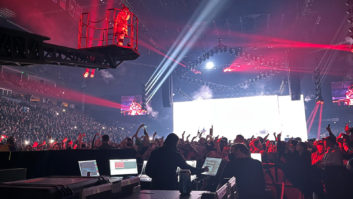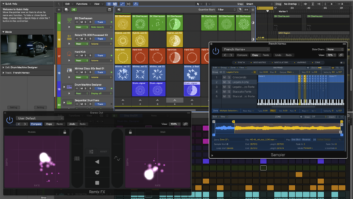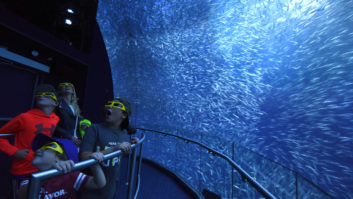MainStage 2 is part of the newest Logic Studio package. MainStage lets you map hardware MIDI controllers to parameters that control their sound, but rather than directly tying MIDI controllers to sound parameters, most MIDI messages are first routed to a customizable visual layer of onscreen controls. You can create screen controls with virtual knobs, faders, meters, etc., to mimic their MIDI hardware controllers, or additional screen controls can be manipulated via mouse.
Each screen control can then be mapped to sound parameters on a per-patch basis. Patches are recallable collections of channel strips containing the plug-ins that collectively make a sound. MainStage 2 also offers new screen controls like VU meters and classic Hammond-style drawbars, while predefined groups of screen controls — from simple setups that mirror stompboxes to full-fledged mixing consoles — can be dragged into the layout.
Once your layout is designed, you attach screen controls to sound parameters using Edit mode. For example, in Layout mode I created a single-screen control knob and named it Lush. (Screen control labels can automatically be labeled according to the parameter they’re controlling, or you can give it a custom name as I did.) In Edit mode, I mapped the screen control to the main channel volume of a delay return and to both the wet and dry parameters of the Space Designer reverb plug-in inserted directly on my guitar channel. I inverted the screen control curve going to Space Designer’s dry volume. With this mapping as the Lush knob was turned up, the dry signal was gradually removed while the reverb and delay effects were increased. Back in Layout mode, I mapped a physical volume-style MIDI pedal to my custom Lush screen control so that getting more of an ethereal sound didn’t require taking my hands off my guitar.
Recording, MIDI, More
MainStage 2 offers recording on a limited scale by letting you record a single stereo file that mirrors a selected audio interface output. MainStage 2 can also route MIDI messages to external devices, whether integrating hardware synths or controlling external signal processors in a live performance-management system. A new channel strip-type called External Instrument works with your Mac’s AMS (Audio MIDI Setup) configuration, so integrating external MIDI gear with MainStage’s internal sound generators is a simple matter.
Also new is ReWire support. Getting access to synths in programs like Propellerhead’s Reason is an easy process that’s identical to working with external MIDI gear. I simply created an External Instrument channel strip, and all of Reason’s rack synths appeared as MIDI destinations and the return audio input menu displayed all of Reason’s audio outputs. Unfortunately, MainStage only operates as a ReWire master, so it can’t follow tempo changes via ReWire protocol. Although MainStage can send tempo changes to slave applications, if you’re running tempo-centric programs like Ableton Live, you may find it frustrating to jump into MainStage to do real-time tempo changes.
Guitar Spotlight
Logic’s new Amp Designer is a massive jump beyond the functional but limited Guitar Amp Pro plug-in offered in MainStage’s earlier version. Many new algorithms audibly (and visually) model vintage and modern amps from companies like Fender, Marshall, Vox, Mesa Boogie and even Orange. Cabinet emulation is also provided with mic positioning that now includes distance control and ribbon mic emulation.
The Pedalboard plug-in can quickly create effects chains by simply dragging pedals from a menu that includes colorful stomp boxes such as Rawk, Monster Fuzz and Roswell Ringer onto a carpeted pedalboard. The signal flows from left to right, but click on the name above a pedal to set up a parallel routing scheme that even adds an A/B mixer into the chain. Pedalboard comprises some new and some repurposed Logic plug-in effects and provides a familiar, fun and inspiring format that is optimized for guitarists.
Looping Back Around
The Loopback plug-in is a real-time phrase sampler for creatively building backing tracks as you play. Loopback’s slick user interface immediately displays your recorded audio in a scrolling waveform found just above the transport, tempo, metronome and count-off controls.
To see how Loopback fits into a live performance, I created a new Concert (MainStage’s name for a project) using the Single Amp & Looper template. All patches in the Concert feed into Loopback via an aux send. This let me start a loop with one guitar sound and continue to dub more guitar parts using other sounds from different patches. The provided layout makes it easy to map physical MIDI footswitches to Loopback controls for hands-free operation.
I liked Loopback, but some of its operations felt counterintuitive. For instance, I wanted to lay down an 8-bar rhythm part and immediately start solo’ing over the top of it. Clicking Record started the recording process, and clicking Record again immediately started to loop what I had just recorded. This was fine, but it left me in Record mode. Clicking Record once more dropped me out of record, but by that time the first note of my solo was now part of the loop. I tried using the Play button to drop out of Record and it actually stopped playback. I wasn’t able to discover a workflow to accomplish what I wanted.
Play It Again, Sam
Nothing ruins a backing track performance more than when the unexpected “insert catastrophe” happens. With MainStage 2’s Playback nonlinear audio plug-in, you can jump to the outro or take a second crack at that third verse as you please. Playback resembles Loopback’s interface but does not record. Audio files are imported and rely heavily on identifying sections of the audio file with markers.
If you bounce audio files from Logic, any marker and tempo information is embedded into the metadata and Playback automatically loads that marker list — a cool trick. Buttons are available to jump to previous and next markers, and a Snap To setting can make the jump action happen immediately when the current marker is done playing or at the next beat/bar. And you can make audio tempo changes with the same algorithms used in Logic’s new Flex Time feature.
For me, Playback’s most impressive feature is that multiple instances can be set up on different channel strips with their transport functions grouped together. By bouncing stem mixes and loading each stem into a different instance of Playback, you can mix nonlinear multitrack material live.
I’ve played with backing tracks for 15 years, and my ultimate goal has been to be in a section like chorus 1 and — while it’s playing — make the decision to jump to any other section of the song when chorus 1 is done. In Playback, it seems that the obvious choice would be using the Previous/Next buttons to jump to different marker positions. These functioned as expected when stopped, but when playing they became “unavailable” if I had the Snap To parameter set to Wait for Next Marker. And trying a concert template having screen controls with Previous/Next marker buttons only let me go back to the beginning of the current marker. Apple recommended I customize a layout and dedicate screen control buttons to locate to specific positions. This approach worked but required a separate physical button on a controller for each section of the song. None of this felt intuitive. The biggest problem was using multiple instances of Playback for synchronized stem mixes, when one track would occasionally and inexplicably stop. Not exactly what you want to see from a live-performance tool. Apple is aware of the problem and says that a fix is on the way.
Is It Showtime?
MainStage 2 definitely shows Apple is committed to this app and has been listening to its early adopters. The Amp Designer and Pedalboard features are impressive, but some bugs and workflow issues in the Loopback and Playback plugs leave room for improvement. When MainStage 1 was released, Apple was fast to fix problems and even quickly modified that version’s operation based on user feedback with sub releases. If history repeats itself, MainStage 2.1 should make the grade.





